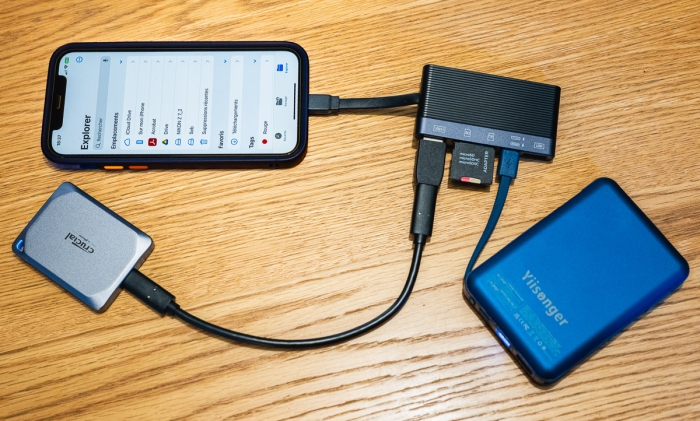How to back up camera photos while traveling – no laptop needed
How to Back Up Your Memory Card Photos While Traveling Without a Laptop?
This is a common question among nomadic photographers, photojournalists, or minimalist travelers using a DSLR or a mirrorless camera. During my professional assignments and vacations, I’ve developed a simple and reliable workflow that allows me to back up my images safely—without carrying my MacBook Pro or even my iPad Mini.
Note: the screenshots included in this guide are in French (iPhone and Nikon menus), but the steps remain identical regardless of your device’s language settings.
The principle is simple: use a smartphone or tablet as a bridge between an SD or CFexpress card and an external SSD via a USB hub. This setup lets you copy all your RAW or JPEG files to a solid backup drive, without relying on a laptop or proprietary backup devices.
This workflow works with all camera brands (Canon, Nikon, Sony, Fujifilm, Panasonic…) as long as you can access the card contents via a compatible reader. It makes outdated solutions like the Gnarbox or Western Digital’s My Passport Wireless unnecessary—devices that are expensive, bulky, and often fragile due to their reliance on spinning hard drives.
First Layer of Backup: In-Camera Redundancy
My Nikon Z cameras have dual card slots (SD + CFexpress). I always configure them to record simultaneously to both cards. This gives me an initial layer of protection in case of data loss or card failure.
During the return trip or after a shoot, both cards remain on me—one inside the camera in my carry-on, the other stored in my wallet or jeans pocket. To strengthen this safety net, I make a third copy on an SSD stored in checked luggage.
Gear You’ll Need to Back Up Without a Computer
To set this up, you’ll need:
- A smartphone (Android or iPhone – USB-C or Lightning)
- A USB-C/Lightning to USB-A/SDCard hub – link
This hub features 2 ports for charging: one USB-C and one Lightning. If your phone connects via USB-C, power the hub via its USB-C port. Same logic applies for Lightning connections. - A portable SSD formatted in ExFAT (Crucial, Samsung T7, etc.)
- A power bank or USB charger for the hub
- An optional universal USB cable if your battery doesn’t have one built-in – link
- A CFexpress card reader if your camera uses that format only
Backup Procedure on iPhone
I use an iPhone 12 Pro with a Lightning port, so the instructions reflect that. If you’re using a newer USB-C iPhone, adjust accordingly.
- Connect the hub to the Lightning port
- Power the hub with a charger or power bank
⚠️ Make sure to plug power into the Lightning port of the hub if the phone is also using Lightning. This hub doesn’t allow cross-charging between ports. - Insert the SD card into the reader
- Connect the SSD to the hub
- Open the Files app and browse to the SD card’s folder
- Long-press to bring up the context menu, tap Copy
- Navigate to the SSD, long-press on empty space, then tap Paste
Backup Procedure on Android
On Android, the interface may vary depending on brand (Samsung, Xiaomi, Pixel, etc.). In most cases:
- Connect the hub and power source
⚠️ If the phone is connected to the hub via USB-C, power must also go into the hub’s USB-C port. - Launch a file management app (Google Files, Xiaomi File Manager…)
- Navigate to the SD card
- Select the folder, tap Copy
- Navigate to the SSD and tap Paste
- A notification will confirm completion and allow safe ejection
File Organization and Backup Safety
After each shooting session, I create a new folder on both my SD and CFexpress cards using the Nikon camera’s Storage Folder menu.
This helps me quickly identify which folder needs backup and prevents duplicates. By the end of the trip, I always have three physical copies of my images:
- One SD card inside the camera
- A second SD or CFexpress card stored separately on me
- A backup copy on an SSD in my checked luggage
My experience as a photojournalist in news agencies and my background managing photographic workflows for editorial teams have led me to develop this method. It now brings me real peace of mind while traveling, ensuring my images are safe without unnecessary complexity.
Conclusion
Backing up your memory card photos while traveling no longer requires a laptop. With a few carefully chosen accessories and a consistent workflow, you can confidently protect all your pictures—even when traveling light. A reliable and field-tested solution.
Sebastien Desnoulez is a French photographer. All tools shown in this tutorial are cross-language.
Note: the Amazon links in this article are not affiliate links. They’re shared for convenience only, to help you find the gear I personally use or recommend. I do not earn any commission from these links — setting up Amazon affiliate accounts is too much hassle… for a few cents.
Tags
Je suis représenté par la galerie
Une image pour rêver





